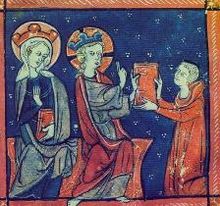Philippe de Beaumanoir (lawyer)
Philippe de Beaumanoir or Philippe de Rémi (* between 1247 and 1250; † June 7, 1296 at Moncel Castle) was a royal office holder in medieval France and a lawyer .
He was a younger son of the poet Philippe de Rémi, who had already served as royal Bailli in the Gâtinais . Beaumanoir received only a small legacy from his father, which is why he took up a law degree at the University of Orléans to qualify for a career in royal administration.
From 1279 to 1283 Beaumanoir officiated as Bailli in Clermont-en-Beauvaisis , from 1284 to 1287 as Seneschal des Poitou and until 1288 in the Saintonge . After a diplomatic mission in Rome in 1289 he was appointed Bailli des Vermandois and in 1291 Touraine . From 1292 until his death he held the Senlis Balliage .
He died in the Moncel castle he built and was buried in a church in Compiègne . Moncel (near Pontpoint , now in the Oise department ) passed into the possession of the crown after his death, where King Philip the Fair set up an abbey for the Poor Clares .
plant
Around 1280 Beaumanoir began with the written fixation of the customary rights of his office in the Beauvaisis. In the work with the title Coutumes du Beauvaisis ("Habits of Beauvaisis"), completed in 1283 , he recorded, among other things, his experiences in his office in 70 chapters and described an ideal image of a royal regional official, his character qualities and professional training. More than just a collection of common law, this work is a true textbook on law. In it, Beaumanoir appears as an advocate of customary law in northern France, which ensures social peace, but also allows Roman law to be strongly influenced by Roman law , especially in contract and procedural law, in his own time .
The Coutumes du Beauvaisis are among the best known and most important of the 13th century French legal collections. On the basis of the “common good”, it soon merged with the Coutumes de Paris to become one of the first national legal instruments for France.
It was published for the first time by La Chaumassière in 1690 and served as a reference several times for Montesquieu , who recognized Beaumanoir as a “light of his time”.
literature
- Auguste-Arthur, comte de Beugnot: Les coutumes du Beauvoisis par Philippe de Beaumanoir, jurisconsulte francaise du XIIIe siècle. 2 volumes. Paris 1842.
- Amédée Salmon: Philippe de Beaumanoir - Coutumes de Beauvaisis. 2 volumes. Paris 1899/1900.
- Louis Carolus-Barré: Origines, milieu familial et carrière de Philippe de Beaumanoir. 1983.
- FRP Akehurst: The Coutumes De Beauvaisis of Philippe De Beaumanoir. University of Pennsylvania Press, 1992 (English translation).
- Michael Stolleis: Lawyers. A biographical dictionary from antiquity to the 20th century. Beck, 2001.
- Hiram Kümper: BEAUMANOIR, Philippe de. In: Biographisch-Bibliographisches Kirchenlexikon (BBKL). Volume 24, Bautz, Nordhausen 2005, ISBN 3-88309-247-9 , Sp. 208-211.
Individual evidence
- ↑ "la lumière de son temps et une grande lumière" (Montesquieu: On the Spirit of Laws , 28th book, chapter 45)
| personal data | |
|---|---|
| SURNAME | Philippe de Beaumanoir |
| BRIEF DESCRIPTION | French lawyer |
| DATE OF BIRTH | between 1247 and 1250 |
| DATE OF DEATH | June 7, 1296 |
| Place of death | Moncel Castle |
